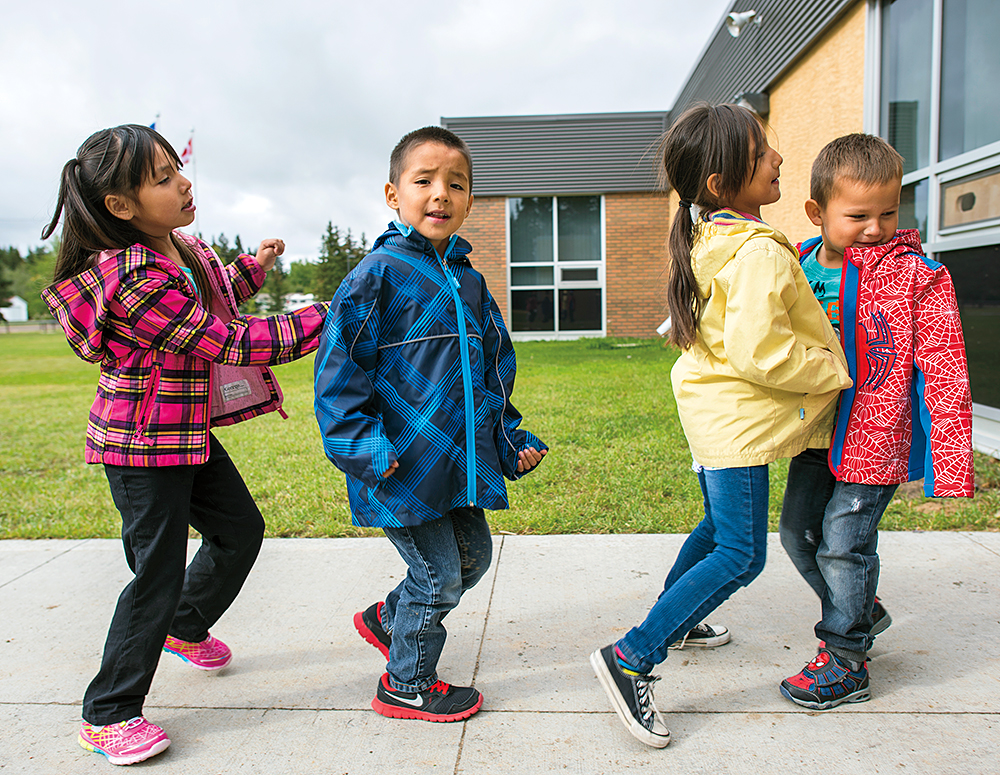
[Photo by John Ulan]
Last June, Jackie Steinhauer finished her inaugural year as an elementary school teacher in Vilna, Alta. - a tiny community not far from Steinhauer's home in Saddle Lake. She revelled in the lively hustle and bustle of her small classroom, a split class of Grade 1 and 2 students, many of whom were Aboriginal students who lived on the nearby reserve.
A member of the Saddle Lake First Nation herself, Steinhauer knows first-hand the importance of incorporating Aboriginal content into all the subjects she teaches these children. She has lived most of her life in Saddle Lake, a tight-knit community steeped in Aboriginal traditions, frequently hosting powwows, round dances and pipe ceremonies among other cultural activities and celebrations. Though she would teach high school Cree language classes later in life, Steinhauer recalls that when she was a young elementary student, she learned nothing about her Cree culture. And for her own children, it wasn't until Grade 4 that they were offered stand-alone Aboriginal studies classes and learned to speak a little Cree.
According to a 2011 Statistics Canada report, the Aboriginal population is expected to grow at an average annual rate of between 1.1 and 2.2 per cent through 2031; potentially more than twice the rate of Canada's non-Aboriginal population at one per cent. There is an urgent need for Aboriginal teachers and teachers with an understanding and knowledge of Aboriginal histories, world view and perspectives in K-12 classrooms. In addition, many newly minted educators end up hired by small community schools, but few remain longer than a couple of years. It's not where they have roots.
The importance of teachers developing a deeper understanding of Aboriginal Peoples' histories and experiences - their ways of knowing and being - was underlined in the recent recommendations from the Truth and Reconciliation Commission of Canada. "All Canadian children and youth deserve to know Canada's honest history, including what happened in the residential schools, and to appreciate the rich history and knowledge of indigenous nations who continue to make such a strong contribution to Canada," write the authors of the report.
The University of Alberta's Aboriginal Teacher Education Program aims to address these issues by attracting education students who are already part of the communities that need serving. For Steinhauer, ATEP was a perfect fit. The innovative program grants bachelor of education students the opportunity to complete their final two years at partnering colleges in rural northern Alberta where they have roots. The majority of the 200 teachers who have graduated from ATEP in the last 12 years have gone on to teach in communities that serve a predominantly Aboriginal student population. And these teachers tend to stick around because they are, after all, at home; they feel a responsibility to their communities.
This familiarity breeds wonderful connections in the classroom. Steinhauer says she was related, either directly or through extended family, to three-quarters of the students in the first class she taught after graduating from ATEP. "I know your kohkom - your grandmother," Steinhauer remembers saying to one student. "She was really good friends with my mom and I used to visit when I was a child." These familial links draw students to their teachers. Teachers become more than just a source of curriculum, but a connection to their lives outside the classroom. They want to hear about their grandmothers, uncles and aunties. "You gain their trust in this way. They want to tell you things."
During their time as ATEP students, Steinhauer and her cohort studied an education curriculum enriched with First Nations concepts. Elders and Aboriginal leaders broadened their understanding of indigenous culture, history and world view. One year, a combined science and physical education course had ATEP students spending a day in canoes on a river with a local First Nations elder, layering lessons about the land with a physical activity. "For our program to be as successful as we want it to be, we need to have that elder support and community involvement," says Angela Wolfe, associate director of ATEP. "And those things cost extra to the program outside of student tuition."
Teaching core concepts through the prism of First Nations culture benefits all children. Steinhauer says her lessons fill the gap between the Aboriginal and non-Aboriginal, benefiting all of her students with a broadened understanding of Aboriginal perspectives and history prior to European settlement. "They have a moment of enlightenment," Steinhauer says. "They understand even if they aren't part of the culture."
The Aboriginal Teacher Education Program equips Aboriginal and non-Aboriginal educators with the skills needed to deliver an elementary education rich in indigenous perspectives, traditions and culture to children in Aboriginal communities.
To learn more about how to support the program, contact Sean Mowat at 780-492-8863 or sean.mowat@ualberta.ca.